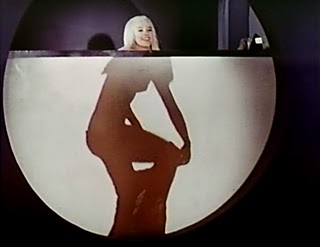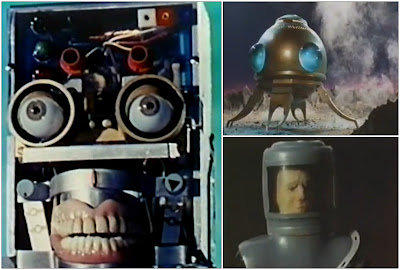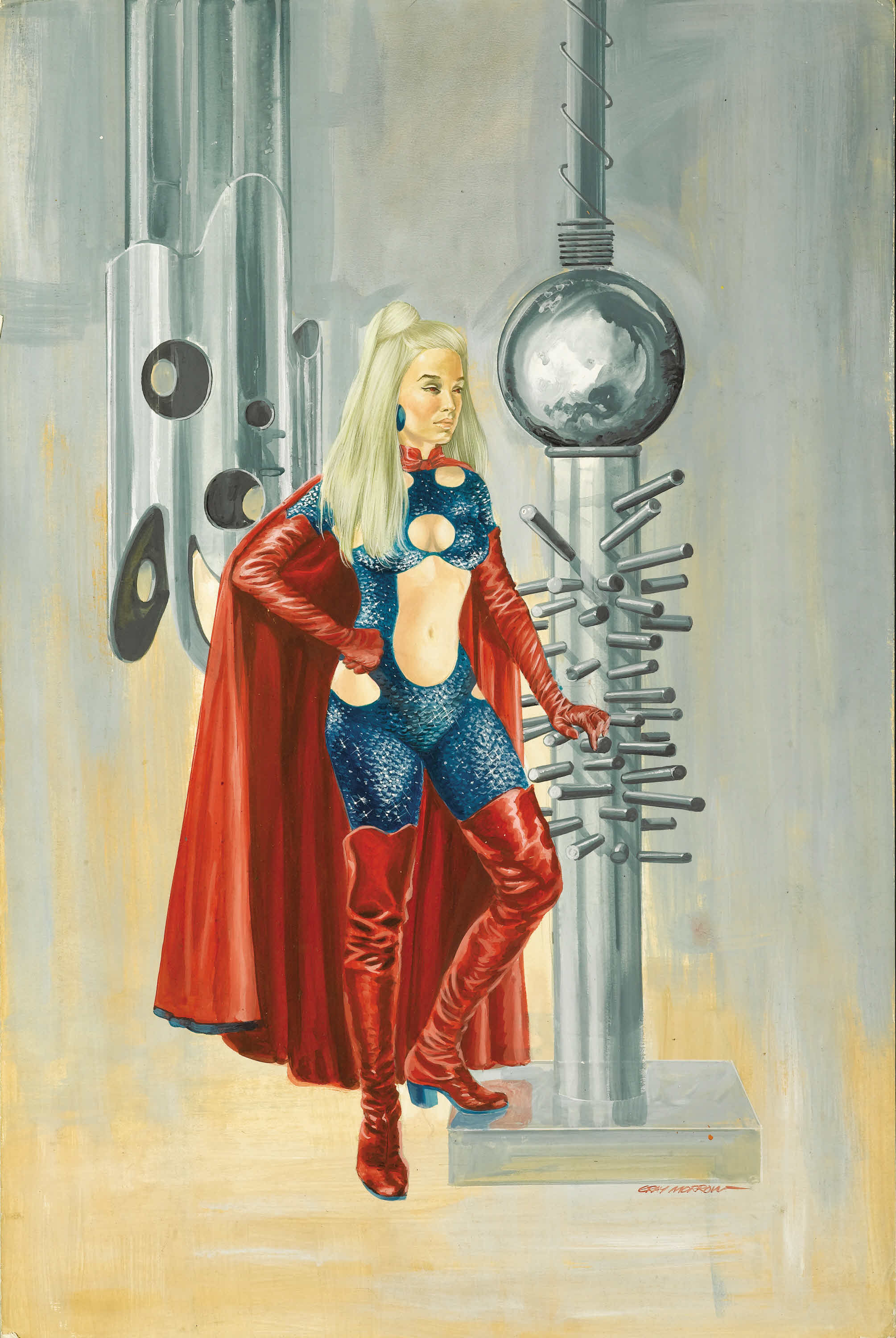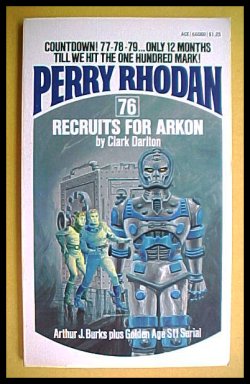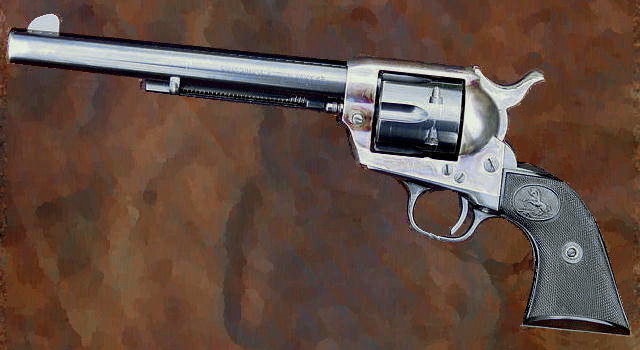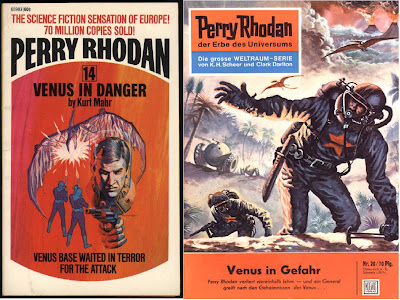

By Kurt Mahr (= German issue #8, 27 October 1961)
Perry Rhodan and company take off from the Gobi Desert aboard the Good Hope for an extended mission to establish a base on Venus. The Third Power and defense of the earth are left in the capable hands of Ras Tschubai and Betty Toufry. Their first stop is to be the Arkonide cruiser wreckage on the moon, but as they approach they find a crashed duplicate of Rhodan's old Stardust– which fires on them! It is the secret US rocket Greyhound, which had been sent to scavenge from the crashed Arkonide ship, with the astronauts Michael Freyt (an old colleague of Rhodan's), Conrad Derringhouse, Rod Nyssen, and William Sheldon (who died in the Greyhound's crash). They mistakenly took the approaching Good Hope for a Mind Snatcher attack and opened fire. Too quickly for Rhodan to stop her, Thora retaliates with a “crystal field neutralizer” disintegrator beam that dissolves the hull of the Greyhound– and reveals to the US astronauts who recognize the technology that it's really the Third Power. The Good Hope lands nearby. “Well, the only thing we can do now is walk over to them and apologize for having attacked them by mistake!” (p. 109)
Rhodan overrules Thora's objections to letting Freyt and his men aboard the space sphere – Freyt was the pilot who destroyed her cruiser (#2[a], The Radiant Dome) – forcefully asserting his command authority. Afterward, Khrest cautions Rhodan that another such clash of wills with Thora may well drive her to the brink of insanity. Rhodan dresses down Washington for their perfidious attempt at “piracy” - and demands reparations in the form of a discharge for the three astronauts from US service so they can join him if they so wish. They so wish. The Good Hope then spends several days salvaging and inventorying machinery and supplies that survived the destruction of the cruiser. Thora agrees to submit to Rhodan's command authority henceforward; Khrest points out that only now has she given up hope that the cruiser could be returned to spaceworthy condition and accepted that she must depend on the earth if she hopes to return to Arkon. The Good Hope proceeds to Venus, but when approaching the landing site selected based on the earlier scouting expedition (from which the Good Hope had been returning at the end of the previous story), a gravitational beam seizes the ship and starts drawing it toward its source. A challenge is received, but it is in a primitive dialect of Arkonide. Only Rhodan's skill as a pilot manages to break the ship free to a landing in a deep crater, hidden from the enemy.
They spend some time scouting the local area, including making contact with primitive but intelligent seal-like creatures who regard them as gods. Then an expedition consisting of Rhodan, Reginald Bell, Eric Manoli, the three US astronauts, Tako Kakuta, and Anne Sloane – along with a robot dubbed “Tom” - sets out to march cross country the three hundred miles to the source of the gravitational beam. Khrest and Thora remain with the Good Hope, which remains undiscovered by various small scout probes that flit through the skies. Over the course of a few long Venusian days (a couple earthly weeks) – and verious harrowing encounters with Venusian monsters – the expedition makes its way across jungles, rivers, and mountains to a high plateau and into a cave which serves as a disintegrator cannon emplacement, which does not fire but does show evidence of being maintained. Not knowing they are being observed by the puzzled commander of the base, and with all other attempts at finding entrance to the base coming to naught, Rhodan finally orders Tako to teleport inside. Tako is captured and interrogated under psychohypnosis by the base commander's robots. Then paths open up for the earthlings to be shepherded into the base, ultimately to a human-like robotic alien who speaks first Japanese, then English, extracted from Tako's brain, and who leads them to a large central chamber housing a gigantic positronic robot brain. “This is the commander. He is happy to see you” (p. 179).
It turns out that the base on Venus was established by Arkonides over ten thousand years ago as a staging area for colonization of the earth – specifically a continent between America, Europe, and Africa – Atlantis. But that colony was destroyed with few survivors in a great cataclysm. The survivors proceeded in the remaining ships to another destination and contact was lost with them. The robot brain has been maintaining the base by means of its robots ever since, through the millennia, waiting for Arkonides to return. It recognizes Rhodan and Bell's psychoenhanced brains as Arkonide, and based on its own observations and what it learned from interrogating Tako it recognizes Rhodan as its new master. Perry Rhodan gains all the weapons, power, resources, and facilities he needs to defend the earth from any alien threat.
Another synopsis may be found at http://perryrhodan.us/php/displaySummary.php?number=8
***
The first impression is that “Base on Venus” refers to the base that Rhodan plans to establish. But in reality, it is the ancient Arkonide base that he discovers and takes possession of.
See my previous comments on the soon-to-be (1962) untenable image of Venus as a primitive earth.
Derringhouse is another name that I remember from my long-ago reading of the later US Perry Rhodan. I actually recognized him when he first appeared in #2(a), The Radiant Dome, accompanying Freyt in the destruction of the Arkonide cruiser, and wondered then exactly how he would be brought to Rhodan's side.
Anne Sloane appears here as another typical female character of an age gone past. She is presented as something of a weak sister, even an outright damsel in distress in one sequence – dragged away by a big worm-monster and saved from a horrific fate only in the nick of time by our heroes. She engages in self-pitying self-recrimination when her telekinetics and “radar-sense” clairvoyance prove to be of little value - “[S]he reported to Rhodan what she had been able to find out about the passageways. She seemed to be discouraged and crestfallen. 'You've lost a lot of precious time, haven't you?” she asked. 'And because of me.'” Our gallant hero denies this, of course (p. 167).
In an earlier story, Khrest intimated that Thora didn't like Anne Sloane because of the attention Rhodan was giving her – she was jealous! Good thing she didn't accompany this expedition, where she could have witnessed Anne pretty overtly flirting with Rhodan: “Anne Sloane pushed her way close to Rhodan. 'It's pretty scary here, don't you agree?' she asked, as if Rhodan were a teenage pal of hers.” Rhodan of course takes her in his arms and comforts her … er, no he doesn't: “Rhodan gave a signal to his troop. 'Let's go!'” (p. 139)
***
Some thoughts on the nature of story-telling in the Perry Rhodan universe:
I think that one of the attractions of Perry Rhodan for me was thirty-odd years ago and continues to be the overall similarity of the idea of a huge, shared universe with what can be found in comic books – whether the DC Universe or the Marvel Universe. (I'm a DC man myself.) I've been thinking along these lines for the last week or so, since a conversation with a colleague on whom I've foisted my three-volume library-bound collection of the recent New Krypton mega-sized story arc in the Superman titles. We were considering how this type of story-telling is almost unique to comics – a huge shared universe in which sprawling stories such as New Krypton, Blackest Night, or a number of other examples that cross over a large number of titles over several months, perhaps even over a year or more, can be told.
It's something that's not possible – or at least not done – on TV, for instance. Most series are there self contained. The only examples that even hint at something larger that come readily to mind are the occasional crossovers that happen (or happened) between, say, the various Jerry Bruckheimer shows, or the various Law & Order iterations, etc. Or when Star Trek: The Next Generation and Deep Space Nine or the latter and Voyager overlapped. Or – an example I threw out, that period in the 1960s when you had the "Hooterville" family of shows – Green Acres and Petticoat Junction, to which was related The Beverly Hillbillies. Not even in the same ball park! Or (and I have only the vaguest notion of such things) perhaps some of the old daytime soap operas – some of them do or did at least have the longevity! In that respect, although it hasn't been continuous, I cannot pass up mentioning Doctor Who– almost as old as Rhodan, appearing first in 1963.
But Perry Rhodan seems to comprise something like the large shared universe in prose form, as I understand it. Already when I was reading the Ackerman translations in the 1970s I was aware of such things as the spinoff Atlan series, the so-called Planet Novels, and so forth. Well, it turns out that thirty-plus years have expanded the Perry Rhodan universe exponentially. Courtesy of the Perry Rhodan Yahoo group member David Sears, here's what it looks like currently:
2582 Perry Rhodan: Main Series;
850 Atlan: Main Series;
12 Atlan: Traversan;
12 Atlan: Centauri;
12 Atlan: Obsidian;
12 Atlan: Die Lordrichter;
12 Atlan: Der Dunkelstern;
12 Atlan: Intrawelt;
12 Atlan: Flammenstaub;
36 Perry Rhodan: Action;
11 Perry Rhodan: Extra;
415 Perry Rhodan: Planet Stories;
6 Perry Rhodan: Classics;
4 Perry Rhodan: Space Thrillers;
5 Perry Rhodan: Autorenbibliothek;
2 Perry Rhodan: Kosmos Kroniken;
6 Perry Rhodan: Andromeda;
6 Perry Rhodan: Odyssee;
6 Perry Rhodan: Lemuria;
3 Perry Rhodan: PAN-THAU-RA;
6 Perry Rhodan: Der Posbi-Krieg;
6 Perry Rhodan: Ara Toxin;
3 Perry Rhodan: Das Rote Imperium;
3 Perry Rhodan: Die Tefroder;
3 Perry Rhodan: Jupiter;
3 Atlan: The Arkon Trilogie (14-16, 1-13 are reprints of Planet Stories, 17 on are reprints of Atlan main series);
2 Atlan: Moewig Fantastic;
3 Atlan: Lepso Trilogie;
3 Atlan: Die Rudyn Trilogie;
3 Atlan: Die Illochin Trilogie;
6 Atlan: Der Monolith Zyklus;
1 Atlan: Rico;
3 Atlan X: Kreta Zyklus;
3 Atlan: Hollenwelt;
3 Atlan: Marasin Trilogie;
3 Atlan X: Der Tamaran Zyklus;
for a total of 4070 Total unique episodes!
I have no idea what most of that material is. Only a minuscule fraction of it is available in English – just the first 146 or so of the Main Series (leaving the third major story arc or “cycle” incomplete), five of the Atlan adventures, and one Planet Story were published back in the 1970s; as I understand it another four of the Main Series appeared as an abortive attempt to restart US publication sometime in the 1990s; and another abortive attempt to bring Perry Rhodan back to the US several years ago folded after only one volume, the first of the six Lemuria stories. And a lot of that mass of material listed above is currently available to the German readers – there have been several reprint series, starting at the beginning and republishing the stories in sequence, as well as collections in various paperback, trade, and hardcover formats as well as, most recently, electronic versions. It is a wide, wonderful, accessible universe … if you read German. Unfortunately, I do not. Sigh.
It does occur to me that there is something similar in the making in the Star Trek and Star Wars licensed novels, but the similarity is only superficial, especially in the case of the former. Back in the day, I read a lot of Star Trek novels; they are almost all in independent continuities with no connection and many inconsistencies between them. As I understand it the Star Wars novels from the early 1990s forward do in general fit into some kind of overall continuity and there is some effort at keeping some kind of consistency – but I've read few of them. And in both cases anything that appears in print may well be later rendered outside any continuity by a subsequent show or movie which then preempts canonicity.
To bring this back toward my initial point, I see a lot of similarity between Perry Rhodan and the comic book universe (multiverse?) that I love so deeply. The breadth of story-telling is just one aspect. There is of course also the larger-than life characters facing universe-threatening menaces. And I already mentioned in a previous post how my discovery of the Mutant Corps in Perry Rhodan coincided with my discovery of the “All-New, All-Different” X-Men (I've not always been exclusively DC!). As I continue reading my way from the beginning, such similarities will doubtless be a recurring theme as I try to convey my renewed enthusiasm for “Die Grosse Weltraum-Serie” “the Great Space Series” (thanks, Google translator).
Cheers!





































